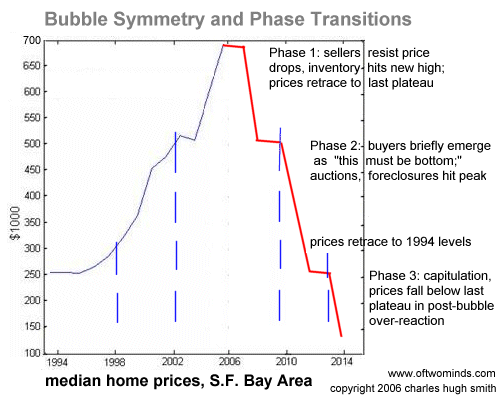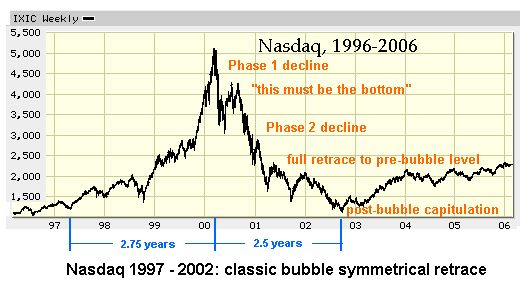

|
| weblog/wEssays archives | home | |
|
Phase Transitions, Symmetry and Post-Bubble Declines (August 2, 2006) Yesterday's invocation of "phase transition" inspired me to apply this concept to the the real estate market/bubble. The result: this chart. 
There are differences between the stock market and the housing market, of course--chiefly that housing is remarkably illiquid compared to stocks. That is, it is quick work indeed to sell a stock, as there is always a market for any tradable security. Not so with real estate; as the cliche goes, "you only need one buyer" but that one buyer can seem awfully scarce in periods of declining prices. Sellers of real estate are also famously reluctant to drop their price in declining markets. This reluctance in the face of rising inventories characterizes Phase 1, a period of modestly declining values from the peak. But when foreclosures begin forcing sales, an abrupt transition occurs, and home prices will fall rapidly. Once distressed properties are sold at auction, then an exchange similar to the stock market takes over pricing: if a property has to be sold, regardless of price, then the price will drop to the point that it finds a buyer, just as a stock eventually finds a buyer. Despite the differences between housing and stocks, bubbles share some basic characteristics which can be described in a Phase 1, 2 and 3 analysis. Phase 2 begins when prices retrace to the most recent plateau, at which point buyers emerge in the mistaken belief that "this is the bottom." This trait is clearly visible in a phase transition analysis of the Nasdaq dot-com era bubble: 
After this burst of euphoria expires under increasing inventory/sales, then Phase 2 is characterized by a massive decline in prices back to the pre-bubble level. Technical analysts will be familiar with this as the C to D move in a classic A-B-C-D pattern. Phase 3 is the capitulation stage, when prices over-react to the downside and actually drop beneath the pre-bubble levels. This pattern is easily seen in the above Nasdaq chart. There is no reason to believe that the housing market won't suffer a similar capitulation and retrace to levels once thought impossible. The other key characteristic of post-bubble declines is the near-symmetry of the ascent and decline periods. Note that the Nasdaq bubble took about 3 years or so to reach its zenith, and about 2.5 years to retrace the entire bubble rise plus some. Again, there is no reason to believe that housing's descent will differ much from the stock market's post-bubble decline, except that each phase transition pause between legs of the decline may last longer than equivalent stock market pauses. The reason is, again, the illiquid nature of the real estate market. The net result: the housing bubble required about 8 years to reach its zenith. It is therefore likely to take a similar length of time to reach its final capitulation/over-reaction price level. No doubt some can quibble about details, but the classic stages of post-bubble decline make a compelling case that indeed, "this time it is NOT different." For more on this subject and a wide array of other topics, please visit my weblog. copyright © 2006 Charles Hugh Smith. All rights reserved in all media. I would be honored if you linked this wEssay to your site, or printed a copy for your own use. |
||
| weblog/wEssays | home |